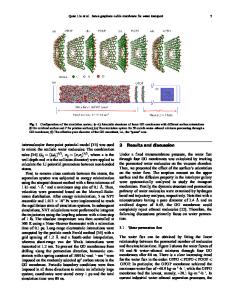Fabrication and characterization of flexible electrochromic membrane based on polyaniline/reduced graphene oxide
- PDF / 620,404 Bytes
- 7 Pages / 584.957 x 782.986 pts Page_size
- 106 Downloads / 373 Views
School of Fashion Technology, Shanghai University of Engineering Science, Shanghai 201620, China Address all correspondence to these authors. e-mail: [email protected] b) e-mail: [email protected] a)
Received: 3 January 2019; accepted: 5 March 2019
Wearable electrochromic devices are considered as the essential components for the development of smart clothing with the intelligent sensing, actuating, and displaying functions. In this study, the electrochromic composite flexible membranes of polyaniline (PANI) and reduced graphene oxide (RGO) were fabricated by in situ polymerization of aniline monomer in the presence of RGO dispersion. The effects of RGO concentration on the morphology, chemical structure, crystallinity, and electrochromic behavior of the composite membranes were studied. Our experimental results show that the conductivity of PANI/RGO composite membrane increases with the increasing of RGO concentration from 0.1 to 0.25 wt%, and the highest conductivity is 3.57 S/cm. An improved electrochemical performance with good electrochromic cycle characteristic of the PANI/RGO composite can be obtained, which shows a wide color range from green to black compared with the PANI membrane that ranging from green to dark blue. This research provides a systematical investigation of flexible PANI-based electrochromic membrane, which has the potential application in the field of wearable electrochromic devices in the future.
Introduction Electrochromic materials have attracted many attentions due to their wide application in smart windows, reflective mirrors, and stealth clothing [1, 2, 3]. Among them, inorganic electrochromic materials are widely used because of their fast response speed and high color contrast, but they are expensive and have poor stability of repeated circulation materials. By contrast, the conductive polymer (CP) matrix is an electromechanical chromogenic material with low price, higher optical contrast, fast switching speed, rich color, and good processing [4, 5]. Polyaniline (PANI) is a CP electrochromic material, and it has attracted considerable attention due to its convenient synthesis, controllable conductivity, high specific capacitance, unique color changing mechanism, and obvious color change [6, 7, 8]. Numerous researchers have dedicated their efforts to prepare PANI and its composite with good electrochromic behaviors. Chu et al. [9] prepared PANI membrane on fluorine-doped tin oxide substrate by one-step hydrothermal polymerization method. The result reveals that the PANI
ª Materials Research Society 2019
membrane showing a good electrochromic performance can be used as electrochromic layer in an electrochromic device. Zhang et al. [10] prepared rod-like PANI/nanocellulose composites with a core–shell structure by in situ polymerization. The result shows that the nanocomposites have superior membrane-forming properties, and the prepared nanocomposite membranes demonstrate excellent electrochemical and electrochromic properties in electrolyte solution, when compared with the pure
Data Loading...











